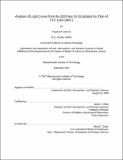| dc.contributor.advisor | James L. Elliot. | en_US |
| dc.contributor.author | Zalucha, Angela M. (Angela Marie) | en_US |
| dc.contributor.other | Massachusetts Institute of Technology. Dept. of Earth, Atmospheric, and Planetary Sciences. | en_US |
| dc.date.accessioned | 2008-09-02T17:57:24Z | |
| dc.date.available | 2008-09-02T17:57:24Z | |
| dc.date.copyright | 2007 | en_US |
| dc.date.issued | 2007 | en_US |
| dc.identifier.uri | http://hdl.handle.net/1721.1/42065 | |
| dc.description | Thesis (S.M.)--Massachusetts Institute of Technology, Dept. of Earth, Atmospheric, and Planetary Sciences, 2007. | en_US |
| dc.description | This electronic version was submitted by the student author. The certified thesis is available in the Institute Archives and Special Collections. | en_US |
| dc.description | Includes bibliographical references (p. 17-18). | en_US |
| dc.description.abstract | We observed a stellar occultation by Titan on 2003 November 14 from La Palma Observatory using ULTRACAM with three Sloan filters: u', g', and i' (358, 487, and 758 nm, respectively). The occultation probed latitudes 2°S and 1°N during immersion and emersion, respectively. A prominent central flash was present in only the i' filter, indicating wavelength-dependent atmospheric extinction. We inverted the light curves to obtain six lower-limit temperature profiles between 335 and 485 km (0.04 and 0.003 mb) altitude. The i' profiles agreed with the temperature measured by the Huygens Atmospheric Structure Instrument [Fulchignoni, M., and 43 colleagues, 2005. Nature 438, 785-791] above 415 km (0.01 mb). The profiles obtained from different wavelength filters systematically diverge as altitude decreases, which implies significant extinction in the light curves. Applying an extinction model [Elliot, J.L., Young, L.A., 1992. Astron. J. 103, 991-1015] gave the altitudes of line of sight optical depth equal to unity: 396 ± 7 km and 401 ± 20 km (u' immersion and emersion); 354 ± 7 km and 387 ± 7 km (g' immersion and emersion); and 336 ± 5 km and 318 ± 4 km (i' immersion and emersion). Further analysis showed that the optical depth follows a power law in wavelength with index 1.3 ± 0.2. We present a new method for determining temperature from scintillation spikes in the occulting body's atmosphere. Temperatures derived with this method are equal to or warmer than those measured by the Huygens Atmospheric Structure Instrument. Using the highly structured, three-peaked central flash, we confirmed the shape of Titan's middle atmosphere using a model originally derived for a previous Titan occultation [Hubbard, W.B., and 45 colleagues, 1993. Astron. Astrophys. 269, 541-563]. | en_US |
| dc.description.statementofresponsibility | by Angela M. Zalucha. | en_US |
| dc.format.extent | 37 p. | en_US |
| dc.language.iso | eng | en_US |
| dc.publisher | Massachusetts Institute of Technology | en_US |
| dc.rights | M.I.T. theses are protected by
copyright. They may be viewed from this source for any purpose, but
reproduction or distribution in any format is prohibited without written
permission. See provided URL for inquiries about permission. | en_US |
| dc.rights.uri | http://dspace.mit.edu/handle/1721.1/7582 | en_US |
| dc.subject | Earth, Atmospheric, and Planetary Sciences. | en_US |
| dc.title | Analysis of light curves from the 2003 Nov 14 occultation by Titan of TYC 1343-1855-1 | en_US |
| dc.type | Thesis | en_US |
| dc.description.degree | S.M. | en_US |
| dc.contributor.department | Massachusetts Institute of Technology. Department of Earth, Atmospheric, and Planetary Sciences | |
| dc.identifier.oclc | 231849330 | en_US |

